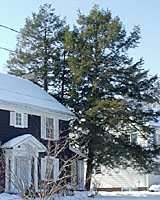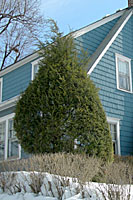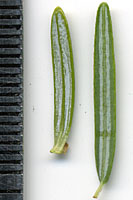Terry L. Ettinger Horticulture Consulting Services
Meeting The Needs Of Today With A Vision For The Future
Special Topics
Evergreen Identification
Hemlock (Tsuga)
 Canadian (or eastern) hemlock (Tsuga canadensis) are planted at the corners of many Central New York homes
(at right) -
even as they can be found growing to heights approaching one hundred feet in Green Lakes State Park just east of the village
of Fayetteville.
Canadian (or eastern) hemlock (Tsuga canadensis) are planted at the corners of many Central New York homes
(at right) -
even as they can be found growing to heights approaching one hundred feet in Green Lakes State Park just east of the village
of Fayetteville.
Hemlock are quite tolerant of annual shearing to retain a manageable size - if started when the plants are very young, that is. However, looking at the very top of the hemlock below it appears that it's finally escaped the bounds of annual shearing!
 Like
yews, the needles of hemlock are flat and attached individually to
the branch. What sets them apart from yews, however, is that they
have two distinct, creamy-white bands running the length of the
underside of each needle. Also, their needles are rarely more than
one-half inch in length, and they're attached to the stem by a tiny
"stem" (technically a "petiole"). Note the small stem/petiole at the base of the hemlock needle, at right
in the picture below, as compared to the fraser
fir needle, at left in the picture below.
Like
yews, the needles of hemlock are flat and attached individually to
the branch. What sets them apart from yews, however, is that they
have two distinct, creamy-white bands running the length of the
underside of each needle. Also, their needles are rarely more than
one-half inch in length, and they're attached to the stem by a tiny
"stem" (technically a "petiole"). Note the small stem/petiole at the base of the hemlock needle, at right
in the picture below, as compared to the fraser
fir needle, at left in the picture below.
 Any small, coniferous evergreen shrub in Central New York landscapes
that has a flat needle with white stripes is almost certainly
a hemlock. In their tree form, however, it might be possible to confuse them with balsam or fraser fir, though not
very likely as
firs are not that common in landscape plantings.
Any small, coniferous evergreen shrub in Central New York landscapes
that has a flat needle with white stripes is almost certainly
a hemlock. In their tree form, however, it might be possible to confuse them with balsam or fraser fir, though not
very likely as
firs are not that common in landscape plantings.